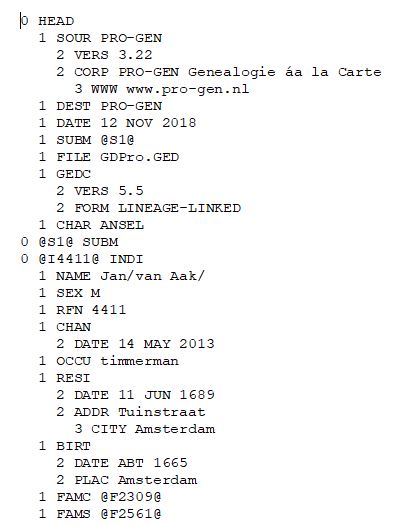Genealogy or family history is a popular pastime in Europe and still even more in the USA. Something we Westerners tend to forget is that many Asian countries have much longer traditions of genealogy, partly due to ancestral veneration or worship. The availability of DNA tests for ethnicity and ancestry surely contributes to the growing army of family enthusiasts.
Modern researchers often use computer software for storing and presenting their data. Already in the early days of the Personal Computer many genealogy applications were developed, most of them as ‘stand-alone’ applications, but now the trend is moving towards cloud computing and online sharing. Basically a genealogy program is a Relational Database Management System (RDBMS), being the front end or user interface of a database engine.

When collaborating with family members and fellow researchers there will be the need for exchanging data. Now because of the diversity of genealogy programs, this is easier said than done. As early as 1984 the genealogical branch of the The Church of Jesus Christ of Latter-day Saints (LDS or Mormon Church) released a specification for exchanging genealogical data, called GEDCOM, an acronym for GEnealogical Data COMmunication. The GEDCOM Standard Release 5.5, introduced in 1996, is still the industry standard after more than twenty years.
But it’s certainly not the case that nothing changed in the genealogical field in the past twenty years. The LDS initiated GEDCOM and released new versions once in a while, but they don’t have as much influence as (for instance) the World Wide Web Consortium (W3C) have on the world wide web and data standards as HTML and XML. According to critics the LDS don’t maintain GEDCOM anymore, partly because they introduced the format for religious reasons, namely the practice of baptising a living person on behalf of a deceased person. Unfortunately there’s no time to get too deep into Mormon theology here.
So GEDCOM is based on a status quo of decades past. Different so called ‘GEDCOM dialects’ originated, that were not fully supported by the standard version. So when your genealogy program contains a field to record a nickname, you should remember that this is not a standard tag in GEDCOM. When exchanging data with another program, data tend to get lost. This is a major problem in genealogy computing. Genealogy software is usually good at importing GEDCOM but not so good in exporting it.
Is there a possible solution for these problems within a relatively short term? The LDS have been working on a new standard called GEDCOM X since 2012, but up till now it did not take the place of the old 1996 version. Another group, the Family History Information Standards Organisation (FHISO) are busy developing a file format called Extended Legacy Format (ELF). The focus of attention here lies in the possibility of consistency in source citation and referencing. Personally I place my bets on the ‘FamilySearch GEDCOM 5.5.1 Specification Annotated Edition (TFG551SAE)’ that was releaesed last May by the Leiden-based computer scientist Tamura Jones. He improved the 1996 GEDCOM specification and enhanced it with annotations. But only time will tell which of these will become the new standard.
References
Website of the Family History Information Standards Organisation (FHISO): https://fhiso.org/
The GEDCOM Standard Release 5.5 specification can be found on: http://homepages.rootsweb.com/~pmcbride/gedcom/55gctoc.htm
When you’re seriously interested in genealogy, software and GEDCOM, you should take a look at Tamura Jones’ website: https://www.tamurajones.net/index.xhtml
GEDCOM X: http://www.gedcomx.org/


Recent Comments